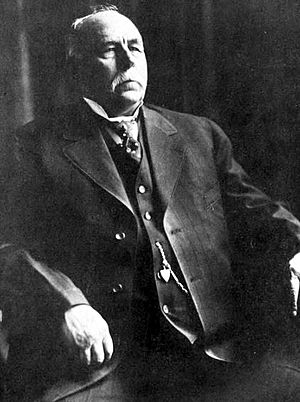Jesse Knight facts for kids
Quick facts for kids Jesse Knight |
|
|---|---|

Jesse Knight ca. 1913
|
|
| Personal details | |
| Born | Jesse Knight September 6, 1845 Nauvoo, Illinois, United States |
| Died | March 14, 1921 (aged 75) Provo, Utah, United States |
| Resting place | Provo City Cemetery 40°13′23″N 111°38′38″W / 40.223°N 111.644°W |
| Known For | Founding of Raymond, Alberta, Canada |
| Residence | Jesse Knight House |
| Spouse(s) | Amanda Knight |
| Children | including: Raymond Knight Inez Knight Allen |
| Parents | Newel Knight Lydia Knight |
Jesse Knight (born September 6, 1845 – died March 14, 1921) was an American businessman. He became very successful in mining in the western United States. He was one of the few members of the Church of Jesus Christ of Latter-day Saints to become very rich in this field during the 1800s.
Jesse's family was poor when he was young. His father, Newel Knight, died when Jesse was a baby. As a young man, Jesse worked to find valuable minerals. In 1896, he discovered the Humbug Mine in Utah. This mine made a lot of money. Because of its success, he bought other mines nearby. These included the Uncle Sam, Beck Tunnel, Iron Blossom, and Colorado mines. After becoming wealthy, Knight helped start a new town. This town was called Raymond in Alberta, Canada. In 1964, he was recognized for his achievements. He was added to the Hall of Great Westerners. This hall is part of the National Cowboy & Western Heritage Museum.
Contents
Jesse Knight's Life Story
Jesse Knight was born in Nauvoo, Illinois. His parents, Newel and Lydia Knight, were important members of the Church of Jesus Christ of Latter-day Saints. When Jesse was one year old, his family had to leave Nauvoo. They were Mormon pioneers following Brigham Young. Jesse's father died in Nebraska in 1847. His mother and eight brothers and sisters kept going. They finally reached the Salt Lake Valley in early 1850.
A Different Kind of Businessman
Jesse Knight was special in the history of mining and business in the American West. He was different from many rich business owners of his time. These owners were sometimes called "robber barons." They often focused only on making money. Jesse Knight was successful because he was good at managing his mines. He knew how to handle claims, workers, money, and technology. He also built companies that worked together well.
However, Jesse Knight was also known for being fair. He owned more mining claims than many others. He did not try to unfairly control the stock market. This was something many other rich mine and railroad owners did. He also treated his workers much better. Other mine owners often took advantage of their workers. But Knight was kind and helpful to his employees.
He built a town for his workers called Knightsville, Utah. In Knightsville, he provided a meetinghouse, a fun hall, and a school. Other mining towns often had places that were not good for families.
Helping Others and His Beliefs
Jesse Knight was very generous. He gave a lot of money to Brigham Young University. He shared this interest with his wife, Amanda. Because of his gifts, people called him the "patron saint" of BYU. He also gave money to his church. He supported many church projects.
His home in Provo, Utah, was comfortable but not overly fancy. It was not like the huge, showy houses built by other rich people. He also did not try to get high political jobs. Many other rich mine owners became senators. But Jesse Knight focused on his businesses and helping others.
People called him "Uncle Jesse" because he was rich but also very giving. He believed his money was meant for good. He thought it should help build up his church. He once said, "The earth is the Lord's bank, and no man has a right to take money out of that bank and use it extravagantly upon himself." This meant he believed money should be used wisely, not just for oneself.
Even though he briefly joined a different political group in Utah, he was a very devoted member of his church for most of his life. He helped his church when it faced money problems. These problems came from legal fights with the government over control of Utah and issues like polygamy.
Founding Raymond, Alberta
After making his fortune in mining, Knight started new settlements and businesses. These were in what is now southern Alberta, Canada. In 1901, Knight bought 30,000 acres of land in Canada. He paid $2.50 for each acre. He started a ranch on this land.
Later, Knight bought another 226,000 acres near his ranch. He then started a town there. This town was built around irrigation farming of sugar beets. He also built a local sugar factory to process the beets. The town was named Raymond to honor his son, Raymond Knight.
Within five years, over 1,500 members of the Church of Jesus Christ of Latter-day Saints moved to Raymond. Most of them came from Utah. The town officially became a city in 1903. Today, Jesse Knight is honored as the founder of Raymond, Alberta.
Legacy
- Knightsville, Utah - a mining town he founded.
- Knightville Road - a road in Juab County, Utah.
- Knight Academy - a school in Raymond, Alberta, Canada.
See also
- Inez Knight Allen - his daughter.
- Ray Knight (rodeo organizer) - his son.
- Tintic Standard Reduction Mill
- Yankee Headframe - a mining structure.
Images for kids



